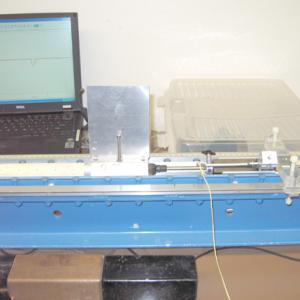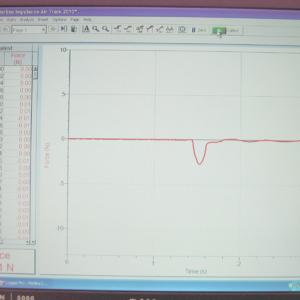College of Liberal Arts & Sciences
1N10.11 - Impulse - Time of contact
Take the spring bumper out of the end of the air track and attach the force sensor to the end with some rubber bands. Start with the hoop spring on the end of the force sensor. Place the launcher on the track about 50 to 75 cm away from the force sensor and set it to the desired spring tension. Place a 1 M, 2 M, or 3 M car against the magnet of the launcher, hit the "collect" button on the interface software, and look at the data when the car hits the sensor. Specifically, you are looking for the "time of contact" for the collision of the car and force sensor spring as can be seen in picture 3 above.
There is also an attachment for the force sensor that allows you to look at "time of contact" for an inelastic collision. When using the same car and spring tension on the car launcher as in the above experiment, you will see that the time of contact is much shorter, but that the force is much larger.
- Stylianos Vasileios Kontomaris, Anna Malamou, "Calculating the Duration of Impact When a Solid Sphere Collides on a Flat Rigid Wall", TPT, Vol. 59, #9, Dec. 2021, p. 696.
- "Figuring Physics", TPT, Vol. 52, # 1, Jan. 2014, p. 60.
- Ole Anton Haugland, "Walking Through The Impulse-Momentum Theorem", TPT, Vol. 51, # 2, Feb. 2013, p. 78.
- Jefferson W. Streepey, "Using iPads to Illustrate the Impulse-Momentum Relationship", TPT, Vol. 51, # 1, Jan. 2013, p. 54.
- "Figuring Physics", TPT, Vol. 46, # 7, Oct. 2008, p. 436.
- Ed van den Berg, Jover Nunez, Alfredo Guirit, "Cotton Buds, Momentum, and Impulse", TPT, Vol. 38, # 1, Jan. 2000, p. 52.
- Edwin A. Karlow, "Piezoelectric Film Reveals F Versus t of Ball Bounce", TPT, Vol. 23, # 3, Mar. 1985, p. 180 - 181.
- The Caliper, "Impulse Comparison for Elastic and Inelastic Collisions", Vernier, Spring 2010, Vol. 27, # 1, p. 4.
- Paul A. Temple, ""Fleeting Event" Demonstration for Freshman Classes", AJP, Vol. 43, #8, Aug. 1975, p. 733.
- Harvard Instructional Physics Labs, "Lab 3: The Force Plate and Vertical Jump", www.fas.harvard.edu/~scphys
Disclaimer: These demonstrations are provided only for illustrative use by persons affiliated with The University of Iowa and only under the direction of a trained instructor or physicist. The University of Iowa is not responsible for demonstrations performed by those using their own equipment or who choose to use this reference material for their own purpose. The demonstrations included here are within the public domain and can be found in materials contained in libraries, bookstores, and through electronic sources. Performing all or any portion of any of these demonstrations, with or without revisions not depicted here entails inherent risks. These risks include, without limitation, bodily injury (and possibly death), including risks to health that may be temporary or permanent and that may exacerbate a pre-existing medical condition; and property loss or damage. Anyone performing any part of these demonstrations, even with revisions, knowingly and voluntarily assumes all risks associated with them.

